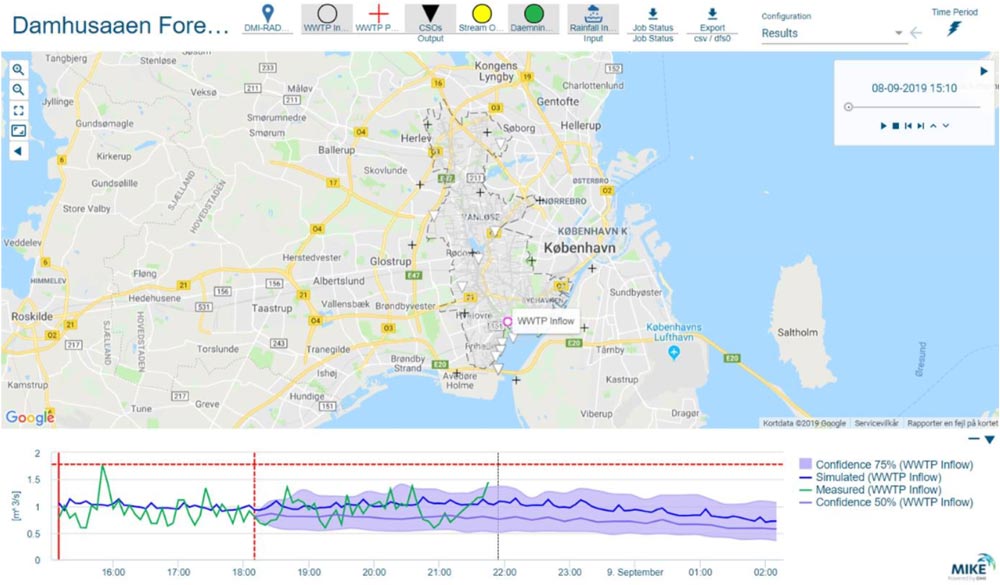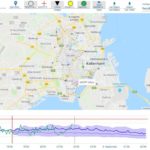The sewer flow forecast toolbox is a machine-learning (ML) based tool for forecasting flow in the sewer network and inflow to the wastewater treatment plant (WWTP), with forecast lead time of up to 48 hours. The tool is based on a combination of (1) real-time water level and flow sensor data from the sewer system, (2) rain gauge data, (3) weather radar observations and nowcasts, and (4) weather forecasts from numerical weather prediction models. The solution provides accurate flow modelling forecast and horizon to support the integrated management of the sewer network and WWTP.
Challenges
Increasingly stringent environmental and economic regulations, constantly growing cities and the general need for adaptation to climate change put pressure on utilities to find new ways of optimising the sewer system across its many shareholders. Integrated urban water management is imperative in this context to reduce adverse impacts on surface waters and minimise future investment costs. In particular, real-time control provides a range of alternative strategies for the integrated management of sewer networks and WWTPs. It can support the reduction of flooding and environmental impacts and enhance the capacity of the treatment plant by defining different operation schemes for dry- and wet-weather situations. Real-time control relies mainly on the availability of reliable flow forecast in order to optimise the operation of the WWTP and manage in-sewer retention capacities.
Limitations of current practices
Flow forecast based on radar data has already been successfully deployed in several EU utilities for real-time control to mitigate combined sewer overflows (CSO), reduce environmental contamination, lower energy consumption and minimise flood risk. For instance, flow forecast has been used for real-time control of the sewer network (e.g. control of pumping stations and in-sewer retention capacities) and WWTP (e.g. optimisation of treatment processes). However, current flow forecast accuracy hampers the full potential of integrated real-time control: large uncertainties (> 100% with a 2-day horizon) are responsible for (1) wrong management decisions, (2) bad management of first flush events and (3) sub-optimal treatment capacities.
Several commercial tools exist for sewer flow forecast (e.g. Infoworks, Mike Urban, SewerCAD) and are today able to consider radar data. These hydrodynamic modelling tools offer great accuracy in real-time flow and pollutant modelling, but the interoperability with radar data yields relatively poor accuracy in extended forecast horizons (2-3 days); and interfaces, methods for uncertainty analysis and visualisation are still missing. No commercial tool exists that combines integrated weather and sewer flow forecast.
Innovation
The benefit of the machine learning methodology is an “end-to-end” approach where all intermediate models and their related parameterizations are implicitly described by the model. For instance, in the case of using weather radar observations and nowcasts, the traditional model chain comprises i) the Marshall-Palmer relation for translating radar reflectivity to rain intensity, ii) bias correction of radar rainfall using rain gauge data, iii) rainfall-runoff modelling, and iv) hydrodynamic modelling of the drainage system for flow prediction. The ML model in contrast, uses radar reflectivity directly, in combination with ensemble weather forecasts, to predict flows. A range of ML algorithms is explored, including different deep neural network configurations and random forests. Further, a statistical error forecast and bias adjustment methodology is applied to obtain probability density forecasts.

The sewer flow forecast toolbox increases forecast horizons and provides more accurate predictions than the hydrodynamic approaches currently available. It also embeds the systematic quantification of forecast uncertainty which improves the reliability of management decisions taken by advanced integrated control solutions (solution 12).
City tests

The sewer flow forecast toolbox is deployed in Copenhagen in the catchment of the WWTP Damhusåen, covering an area of approximately 55 km² and six municipalities (Copenhagen, Frederiksberg, Gladsaxe, Herlev, Rødovdre and Hvidovre). The catchment’s sewer system is mainly combined (85%), with ca. 160,000 m³ established storage volume and ca. 86 combined sewer overflows across the catchment, representing 45% of all overflows in the BIOFOS catchment area (ca. 350 km²). The utilities in charge of operating the sewer system are HOFOR, NOVAFOS and Frederiksberg, while BIOFOS is in charge of operating the WWTP. Runoff in the catchment is primarily transported by means of gravitational forces, and control options are limited. Inflow to the WWTP can be as high as 28,000 m³/ hour, while the plant’s biological treatment capacity is limited to 10,000m³/ hour. This leads to frequent bypass events, on average more than 75 times per year, with untreated sewerage spilled to the surface waters.
Contact solution
DHI – Sten Lindberg : sl@dhigroup.com
BIOFOS – Carsten Thirsing : ct@biofos.dk
BIOFOS – Barbara Greenhill : bg@biofos.dk
BIOFOS – Dines Thornberg : dt@biofos.dk


